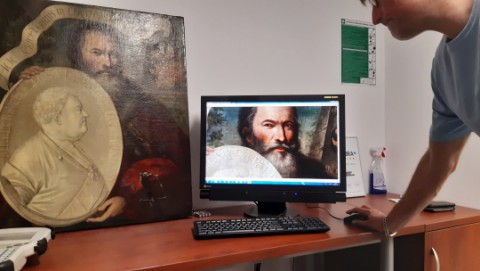Advanced 2D presentation techniques under the project “www.muzeach”
The task “Advanced 2D presentation techniques” involves two ranges of documentation activities. Although they are based on digital photographic documentation, the special way of making and processing these photographs offers a different range of possibilities than photographic documentation.
The first of these techniques is the so-called gigapixel documentation. It involves the creation of high-resolution photographic documentation (two-dimensional) of the selected object. It can be compared to macro photography, but made for the entire surface of an object, not just its small fragment.
Making such documentation involves taking hundreds and sometimes even thousands of pictures of the same object, each covering only a small fragment. Then, the photos are combined using special software to present the data as a single large photo. The use of such an imaging technique makes it possible, for example, to reproduce the surface of a painting with a precision that allows the viewer to see individual cracks in the paint anywhere on the canvas.
By combining many component images, it is possible to achieve a much higher resolution than in the case of a single picture taken even with the most advanced photographic system in the world. The files are then made available using special software that provides the recipient with only a part of the photo – the one displayed on the monitor at a given moment. This visualisation technique is called tessellation. In order to maintain good colour rendition during the shooting, the project will use an advanced colour control system. It involves placing a specified sample colour palette on the photo and quality control of each colour reproduction. This type of documentation will be applied to some easel paintings and fabrics.
The second 2D digitisation technique, called RTI, does not have a Polish name in spite of its advanced age. It has been in use around the world for a number of years. “RTI” is an abbreviation of Reflectance Transformation Imaging. It allows for the creation of a special graphic file that gives the viewer freedom to manipulate the lighting of the photographed object.
The preparation of such documentation requires strictly controlled, variable lighting conditions for dozens of pictures of the same frame. Then, they are processed as registered data and combined into a single image (saved in a special .ptm format). This allows the user to view, for example, a zoomed-in part of a painting with the option to freely manipulate the direction of lighting in real time.
The RTI technique is perfect for documenting all types of textures on historic surfaces, such as paintings with thick layers of paint or the surface of medals and coins. With the widespread availability of free software for the visualisation of .ptm files, it is easy to make the products of this documentation available to viewers. A single file does not weigh more than a few dozen MB and is easy to transmit over the Internet. Due to technical reasons, this type of documentation can only be used for portions of objects with a surface no larger than approx. 40 cm x 40 cm. The project provides RTI documentation for fragments of especially valuable paintings. In addition, they will be fully documented using standard digital photos.
Project co-financed from European Funds and from the funds of the Ministry of Culture and National of the Republic of Poland. The project is implemented under the Operational Program Digital Poland for the years 2014-2020, Priority Axis 2 “E-government and open government,” Action 2.3 “Digital availability and usefulness of public sector information,” Sub-action 2.3.2 “Digital availability of culture resources.”

suggested

Digitisation and 2D publication of exhibits under the project “www.muzeach”
The project “www.muzeach,” co-financed from the Operational Program Digital Poland, includes the task “Digitisation and 2D publication of exhibits.” It …

The project “www.muzeach”, co-financed by the EU, has started
The project “www.muzeach” started on April 1, 2019.

Operational Programme Digital Poland – project “www.muzeach”
The project “www.muzeach” („In museums”) aims to provide public access to digital resources of five museums maintained or co-maintained by …
















